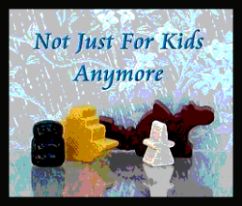
 It doesn't matter if you win by an inch or a mile; winning's winning. --Vin Diesel, The Fast and the Furious
It doesn't matter if you win by an inch or a mile; winning's winning. --Vin Diesel, The Fast and the FuriousWinning: All-or-nothing?
As I noted last week, regardless of what the game ending scores are, the vast majority of games are simply won or lost. It doesn't make a difference in Puerto Rico whether you win 75 to 54, 36 to 35, or even 44 to 44 with an extra doubloon. Either you won or you lost.
This all-or-nothing scoring can compromise the integrity of a game. The fact that a win by a point or a tie breaker is as good as a mile influences the way that strategies and tactics are employed in the game. Whether it is sacrificing points in order to ensure the end-game, stalling for time, or trading with an opponent while in a winning position, the fact of an all-or-nothing victory asserts itself.
But not all games are like this.
Cribbage
I'm hoping someone will point out another games, but the only standalone game that I could think of that includes multiple kinds of wins is Cribbage. The game of Cribbage is played to 121 points. A simple win is when your opponent has scored 91 or higher points. If your opponent scored less than 91, you have "skunked" him; less than 61, you have "double-skunked" him.
If the game was being played for money, you traditionally earn more money for the greater kind of win.
The Honorable Win
The type of win you score against your opponent or opponents cam affect the social aspect of the win. Go is a traditional example, but the same idea can apply to other games.
In Go, there are honorable and dishonorable wins. A win can taunt an opponent or respect an opponent. The difference is not necessarily by the point differential but rather by the tactics used to gain the victory. The specifics are beyond the scope of this article.
In other games, the difference in scoring can be a factor of whether an opponent feels like they have played a competitive and challenging game or whether they have participated in a route. In a sports game, for instance, a large margin of victory is an embarrassment. Also an embarrassment is playing an opponent who is clearly not making an effort.
You can change the nature of a win or loss by the sportsmanship you exhibit after the game.
Cooperative/Solo Games
In this example, the game is scored at the end, and your margin of victory is recorded. Whether you have won or lost this particular instance of the game, the score you've achieved is compared to previous plays of the game. If you have beaten your previous score, you can consider this a win; otherwise, a loss.
In truth, this still devolves into a simple win or loss result; only the yardstick has changed.
Series/Tournaments
Similarly, many games are actually a series of smaller games played one after another. Duplicate bridge, for example, or a sports tournament.
The interim scores you achieve for each particular game in their series may have significance on your overall score. Therefore, you are enjoined to not only win games but maximize your scores in each game. This is really no different than simply trying to score the most on each turn of a regular game; you're simply playing the games as turns in a larger game.
However, good sportsmanship requires you to make a good effort against all opponents, and not to ditch, stall, or throw games just because the game is irrelevant in the series.
Betting
In games where real money or prizes may be won or lost, the margin of victory can be significant.
An obvious example is Poker. After a night of Poker, there is a large difference between having won a majority of hands versus winning all the hands. The final score is the amount of money you take home.
Some tournaments may also reward extra money for achieving a certain win percentage overall.
Activities
There are "games" without traditional styles of scoring at all. Most gamers would probably call these "activities" rather than games. For instance, cooperative games where you always win, or what is called "New Games", which are fun group activities.
Problems
I described the problem with the all-or-nothing win above: instead of playing the best that they can for the entirety of the game, players sometimes go only so far and then say "good enough". Furthermore, players use this knowledge as a tool to "game" end the game, rather than strive to achieve the best score that they can, which is possibly more within the spirit of the game.
On this latter sentiment, I acknowledge that there will be some disagreement; nowadays we think that any tool used to win within the confines of the game should be used. We try to "solve" a game win. While not thoroughly opposed to this view, I think it lacks a certain something in the way of sportsmanship.
On the flip side, there are problems with simply applying gradated wins to friendly games.
Firstly, people don't necessarily want record of their scores kept indefinitely. One of the nice things about games is that we start with a clean slate. Games could get discouraging if we enter them knowing that a victory will simply raise our win rate from 2/100 to 3/101, or 1005 points in 67 games to 1032 points in 68 games.
Sometimes I'm "playing", and sometimes I'm relaxing. This may be a teaching game or a game right before bedtime.
Secondly, the final scores in games are not necessarily accurate reflections of skill levels or play results. A 32 to 30 to 27 game of Puerto Rico might be a masterful win, while a 65 to 53 to 41 game might have been easy sailing. This is because the game provides multiple paths to victory points and multiple end game conditions. Also, while not overly luck driven, luck, and the poor right-hand opponent, still play a part in your victory.
Thirdly, comparing scores, especially in multi-player games, is only useful against the same opponents. The record of my wins against Mary, Joe, and Susan has no real relation to my record against Tom and Cynthia. Not only are the opponent levels different, the number of players was different, and the rules may even have been slightly different (open vs closed holdings, for example).
Solutions
Cribbage offers the first solution to these problems. Both our games, and our game styles, should encourage not only beating our opponent, but different levels of winning.
Casual players can still play Cribbage as win or lose, and they can do that with any other game, as well. Game designers should include in their games different win levels. In games that can end either with high or low scores, the win levels may have to reflect percentage differences. New games could be designed with alternate winning levels in mind.
Secondly, new games could explicitly indicate rewards for certain levels of achievement, such as skunking or double-skunking. If the game says, "Winning by 1 point is a win, by ten points is a Whammy Win, and by fifty points is a Super Whammy Win", incentives are provided to do more; essentially, you are combining the play against your opponents with playing against the board.
Gross steps like 1, 10, and 50 are not actually a perfect solution; in this case, 39 points is the same as 10 points, which is what we are trying to avoid. The best solution would name every point its own level, e.g. 1 point = weak win, 2 points = soft win, 3 points = plain win, 4 points = average win, etc... up to a bit more than is possible.
Thirdly, games are really played against yourself, anyway. Excluding luck factors, you win by making "good" plays or by properly capitalizing on your opponent's errors. You can keep your own logs of games played, if only a mental one. If you play against many opponents, the different levels of the opponents should average out in the end. If you play against only a few opponents, such as at a game group, your scoring measures your growth against yourself, but will probably be less than meaningless as far as any type of real world measurement.
You then use an honor system when choosing to include, or not include, games that "count" or "don't count" in this score.
Fourth, you can make the results of a game influential on future games in a minimal way. A game company could design a whole line of games around this idea, or the entire board game world could adopt one or more systems that interact between games.
Total scores achieved under certain conditions, registered on certain sites, or simply from the last game, could determine the color of your playing piece in the next game, starting position, "banker", title, or some other prestige-based incentive.
Finally, you could simply play every game for money, awarding payment based on the final scores. As no grandfather of mine ever said, you play for money "just to keep it interesting."
Yehuda



